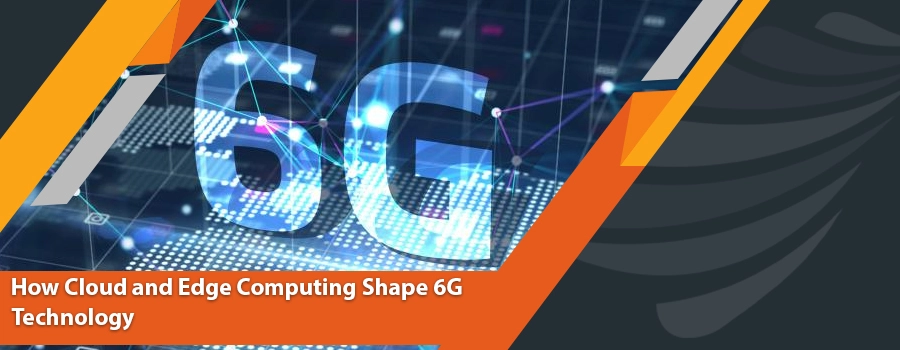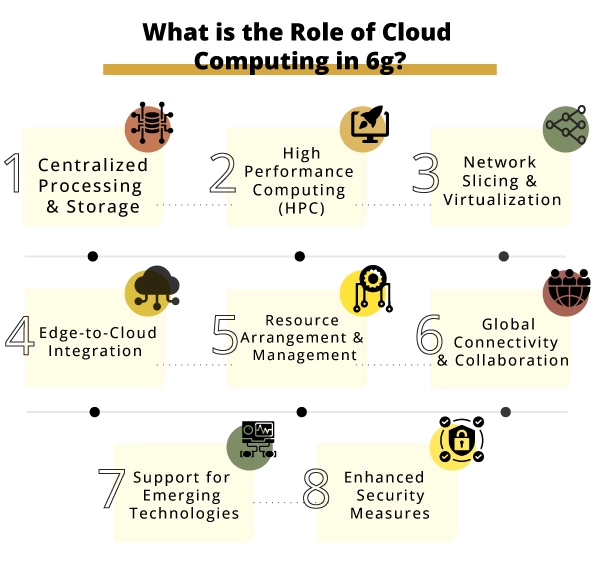In the realm of 6G technology, Cloud and Edge Computing emerge as pivotal players, revolutionizing how we experience the digital world. Cloud Computing serves as a centralized powerhouse, efficiently managing data resources flexibly, while Edge Computing operates closer to the action, reducing delays for instant responses. Together, they create a seamless partnership, optimizing data processing, enhancing user connectivity, and shaping the landscape of 6G. Join us on a technical exploration as we present the collaborative impact of Cloud and Edge Computing, elevating your digital experience in the era of 6G connectivity.
What is Cloud Computing and Edge Computing?
Cloud Computing and Edge Computing are two distinct paradigms in computing, each playing a crucial role in handling data and delivering services.
Cloud Computing involves delivering computing services, including storage, processing power, and software, over the Internet. Instead of relying on local servers or devices, users access and utilize resources hosted on remote servers. Third-party providers typically provide cloud services that can be accessed on demand, allowing scalability and flexibility. Examples of cloud services include cloud storage, virtual machines, and software-as-a-service (SaaS) applications. Amazon Web Services (AWS) and Microsoft Azure, which enable scalable and flexible solutions, are the outcomes of cloud computing.
On the other hand, Edge Computing focuses on processing data closer to the generation source, reducing latency and improving real-time processing. In this paradigm, computing resources are decentralized and brought closer to the network’s edge, often near the devices or sensors producing the data. Edge Computing is particularly valuable for applications that require low latency, such as Internet of Things (IoT) devices, autonomous vehicles, and augmented reality experiences. It enhances efficiency by processing critical data locally, minimizing the need to transmit all data to centralized cloud servers.
What is 6G?
6G aims to provide seamless connectivity in diverse environments, including rural and remote areas. This could involve innovative solutions to bridge the digital divide and ensure widespread access to high-speed internet. According to industry reports, 6G is projected to achieve data speeds up to 100 times faster than 5G, reaching an astounding one terabit per second.
This leap is expected to open doors for innovative applications, pushing the boundaries of what is currently possible. 6G is anticipated to unlock new use cases and applications beyond traditional communication. This could include innovations such as augmented reality, holographic communication, and advanced IoT applications.
What is the Role of Cloud Computing in 6g?
The role of Cloud Computing in 6G is expected to be pivotal, building upon the foundations laid by previous generations of mobile networks. While the specific details may evolve as technology progresses, the anticipated roles include:
1. Centralized Processing and Storage
Cloud computing in 6G will continue to serve as a centralized hub for processing and storing vast data. Centralized cloud resources enable efficient management and allocation of computational power, contributing to the scalability and flexibility of the network.
2. High-Performance Computing (HPC)
6G will likely leverage Cloud Computing for High-Performance Computing (HPC) tasks. This includes resource-intensive applications such as complex simulations, artificial intelligence (AI), and data analytics that benefit from the computational capabilities of cloud servers.
3. Network Slicing and Virtualization
Cloud-based network slicing is expected to be a key feature in 6G. This allows the network to be divided into virtual slices, each tailored to specific use cases with unique requirements. Cloud Computing facilitates the virtualization of network functions, enabling dynamic allocation and management of resources.
4. Edge-to-Cloud Integration
6G will likely emphasize seamless integration between Cloud and Edge Computing. While Edge Computing handles real-time, low-latency processing at the network edge, Cloud Computing provides the centralized power needed for complex computations and data storage. The synergy between these two paradigms aims to optimize overall network performance.
5. Resource Arrangement and Management
Cloud Computing in 6G will be crucial in arranging and managing resources efficiently. This involves dynamically allocating computing and storage resources based on demand, ensuring optimal performance across diverse applications and services.
6. Global Connectivity and Collaboration
Cloud services provide a platform for global connectivity and collaboration. In 6G, Cloud Computing will facilitate seamless communication and data exchange on a global scale. This is particularly important as 6G aims to connect diverse devices, industries, and applications.
7. Support for Emerging Technologies
Cloud Computing will support integrating emerging technologies in 6G, such as augmented reality, virtual reality, and advanced IoT applications. These technologies often require significant computational resources, and the cloud infrastructure can provide the necessary support.
8. Enhanced Security Measures
Cloud-based security measures are expected to be vital in securing 6G networks. Cloud services can implement advanced security protocols, threat detection systems, and encryption to safeguard data transmitted across the network.
What is the Role of Edge Computing in 6g?
The role of Edge Computing in 6G is anticipated to be significant as it builds upon the advancements of previous generations and addresses the evolving demands of a highly connected and data-intensive world. Here are key roles and contributions expected from Edge Computing in 6G:
1. Low-Latency and Real-Time Processing
Edge Computing in 6G will play a crucial role in reducing latency by processing data closer to the point of generation. This is vital for real-time responsiveness applications like augmented reality, virtual reality, and critical communication systems.
2. Decentralized Data Processing
Unlike centralized Cloud Computing, Edge Computing distributes computational processes across the network’s edge, minimizing the need to transmit data to distant cloud servers. This decentralized approach enhances efficiency, particularly for time-sensitive applications.
3. Enhanced Mobile Computing
6G is expected to bring about advancements in mobile computing, and Edge Computing will be integral to this evolution. Edge Computing contributes to a more seamless and responsive mobile computing experience by enabling processing tasks at the network’s edge.
4. Support for Internet of Things (IoT)
Edge Computing is well-suited for supporting the massive influx of IoT devices expected in 6G. By processing data locally at the edge, Edge Computing reduces the strain on network bandwidth and enhances the overall efficiency of IoT applications.
5. Edge Intelligence and AI Integration
6G will likely incorporate advanced artificial intelligence (AI) capabilities, and Edge Computing is key in enabling edge intelligence. This involves deploying AI algorithms at the network edge to analyze and act on data in real-time, contributing to smarter decision-making.
6. Edge-to-Cloud Synergy
Edge and Cloud Computing are expected to work in tandem to optimize network performance. While Cloud Computing provides centralized processing power, Edge Computing handles immediate, localized processing needs. The synergy between these two paradigms ensures a balance between efficiency and scalability.
7. Customized Network Slices
Edge Computing enables the creation of customized network slices in 6G, tailoring network resources to specific applications and use cases. This dynamic allocation of resources based on specific requirements enhances the overall adaptability and responsiveness of the network.
8. Autonomous Systems and Robotics
6G is likely to witness increased integration of autonomous systems and robotics. Edge Computing supports these applications by providing the necessary computing power for real-time decision-making, allowing devices to operate more autonomously.
9. Edge Security Measures
Security is a critical aspect of 6G, and Edge Computing contributes to this by implementing security measures at the network’s edge. This approach helps address security concerns closer to the source of data generation.
The Power Duo of Cloud and Edge in 6G Technology
In the realm of 6G technology, the collaboration between Cloud Computing and Edge Computing takes center stage, promising an enhanced and responsive connectivity experience. Let’s dive into the numbers that highlight the impact of this powerful partnership:
1. Efficient Data Processing
As a centralized processing hub, Cloud Computing will contribute to a remarkable global cloud computing market exceeding $800 billion by 2026. This emphasizes its role in efficiently managing and processing data on a massive scale.
2. Edge Computing’s Surge
Edge Computing, the nimble counterpart, is estimated to drive a global market surpassing $15 billion by 2025. This surge reflects the increasing recognition of its ability to process data closer to the source, reducing latency and enhancing real-time capabilities.
3. Dynamic Resource Allocation
The synergy between Cloud and Edge Computing is set to redefine resource management. Cloud services enable dynamic resource allocation, ensuring optimal performance across diverse applications. This collaboration addresses the dynamic demands of an ever-evolving digital landscape.
4. Global Impact
Cloud-based services are not confined by borders, facilitating global connectivity and collaboration. The global cloud computing markets projected that the global cloud computing market is expected to grow from USD 626.4 billion in 2023 to USD 1,266.4 billion by 2028 at a CAGR of 15.1%. This signifies its role in creating a connected world that transcends geographical limitations.
5. Optimizing User Experience
The collaboration between Cloud and Edge Computing aims to elevate the user experience. As we anticipate 6G’s arrival, this partnership is expected to create a seamless blend of centralized power and decentralized agility, resulting in a powerful and responsive network.
Why Should You Care?
In the ever-evolving landscape of technology, you might wonder, “Why should you care about the collaboration between Cloud and Edge Computing in the context of 6G?” Here are compelling reasons why this technological synergy matters:
1. Lightning-Fast Connectivity
The partnership between Cloud and Edge Computing in 6G is poised to deliver unprecedented data speeds up to 100 times faster than 5G. This means quicker downloads, smoother streaming, and near-instantaneous responses for applications that demand speed.
2. Real-Time Experiences
Whether you’re into gaming, augmented reality, or virtual reality, the reduced latency by Edge Computing in 6G ensures real-time experiences. Imagine immersive gaming without lag or seamless augmented reality interactions – it’s all within reach.
3. Efficient Resource Management
The orchestration of resources between Cloud and Edge Computing optimizes data processing. This enhances the network’s overall efficiency and contributes to a more sustainable use of resources, making technology work smarter for you.
4. Empowering New Possibilities
The 6G era, fueled by Cloud and Edge Computing, opens doors to innovative applications. From advanced healthcare solutions to smart cities and autonomous systems, the collaboration brings about technological advancements that can positively impact various aspects of our lives.
5. Global Connectivity
Cloud services provide a platform for global connectivity and collaboration. In an interconnected world, this means seamless communication, data exchange, and cooperation on a global scale. The implications go beyond personal convenience, extending to international collaboration and progress.
6. Tailored User Experiences
The partnership between Cloud and Edge Computing aims to create a network that adapts to your needs. Whether in a bustling city or a remote area, 6G seeks to provide a consistent and tailored user experience, ensuring that connectivity is not a one-size-fits-all concept.
7. Economic Growth and Innovation
The anticipated economic impact of 6G, driven by Cloud and Edge Computing, is substantial. Projections indicate over $3.5 trillion in contributions to the global economy by 2030. This signifies not just technological progress but also the potential for economic growth and innovation on a global scale.
Final Thoughts
The collaborative force of Cloud and Edge Computing in 6G technology promises a future of unparalleled connectivity, efficiency, and transformative user experiences. Cloud Computing efficiently manages data resources, enabling global connectivity and supporting emerging technologies. Simultaneously, Edge Computing operates at the network’s edge, focusing on low-latency processing, real-time experiences, and customized network slices. This power duo promises lightning-fast connectivity, efficient resource management, and a seamless blend of centralized power and decentralized agility, ultimately shaping a future where technology transcends boundaries, delivering unprecedented user experiences and fostering global innovation.





